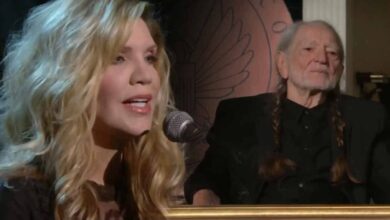Listening To Marty Haggard’s Son Sing His Father’s Song Brings Us To Tears
The influence of “Mama’s Hungry Eyes” extends far beyond its emotional depth and narrative quality; it stands as a reflection of the cultural ethos that informs much of country music. This genre often draws upon personal experiences and tales that resonate widely, and Merle Haggard’s song exemplifies this with its vivid storytelling and exploration of maternal love. While country music has its roots in the struggles of common folk, Haggard’s poignant lyrics encapsulate the essence of working-class family life. The song serves as a poignant reminder that even in the most trying circumstances, love and dedication can flourish, offering a beacon of hope amidst adversity.
Merle Haggard was born on April 6, 1937, in Oildale, California, into a family facing financial hardship during the Great Depression. His father, who was also a musician, passed away when Haggard was just nine years old, leaving his mother to raise him and his siblings alone. This formative experience shaped Haggard’s perspective on life, inevitably influencing his songwriting. He often wrote about his family’s struggles and the hard truths of life, allowing listeners to connect with his narratives on a deeply personal level. “Mama’s Hungry Eyes” reflects this connection; it’s not merely a tribute to his mother but also a universal acknowledgment of the sacrifices mothers make for their children.
As part of the Bakersfield sound identity in country music, Haggard’s style combined honky-tonk with elements of rock and roll, creating something refreshingly authentic. His musical prowess and heartfelt lyrics quickly garnered popularity, and he became one of the genre’s most significant figures. Throughout his career, Haggard received multiple awards and honors, solidifying his position as a key influencer in country music. Songs like “Mama’s Hungry Eyes” have cemented his legacy, ensuring that the emotions behind the lyrics will resonate with future generations.
Marty Haggard’s decision to revisit “Mama’s Hungry Eyes” is more than just a tribute; it reflects a continuing legacy within the family. As the son of one of country music’s legends, Marty faced the challenge of honoring his father’s work while also carving out his own identity in the industry. By crafting a version of the song that builds upon the original, he managed to keep the essence intact while also introducing a modern interpretation that resonates with today’s audiences. His musical journey is characterized by the influence of his father, yet he brings his unique flair and insight, which adds richness to the song’s narrative.
In terms of the broader impact of “Mama’s Hungry Eyes,” the song has inspired countless artists across various music genres. The themes of familial loyalty and the strength of a mother’s love are universal and timeless, transcending geographical and cultural boundaries. When covered by other artists, the song frequently retains its core message while being infused with new interpretations, a testament to its relatability and emotional resonance. This cross-generational dialogue between artists helps to keep stories like Haggard’s alive and relevant, serving as a vehicle for shared experiences and collective memory.
The song also reflects the changing landscape of societal expectations regarding motherhood and family dynamics. As times evolve, the narratives surrounding parental roles shift as well. Haggard’s depiction of a hardworking mother is a tribute that highlights her unwavering spirit amidst adversity, positioning her as a central figure in the family. This portrayal is both relevant and poignant today, as discussions around the challenges faced by single parents continue to emerge, making “Mama’s Hungry Eyes” a timeless anthem of recognition and love.
As the years have passed, “Mama’s Hungry Eyes” has been included in numerous compilations and playlists dedicated to classic country music. Its longevity is a testament to the song’s ability to touch hearts and evoke memories. Listeners often find themselves reflecting on their own family experiences when they hear the song, which speaks to Haggard’s ability to express what many feel but may not have the words to articulate. The emotional depth woven within the melody evokes nostalgia and appreciation for the sacrifices made by parents everywhere.
Beyond its commercial success, the narrative embedded within “Mama’s Hungry Eyes” has served educational purposes in various contexts, including classes on songwriting and American literature. It is frequently cited as an example of effective storytelling in music, where the personal becomes universal, inspiring analysis and discussion about themes of struggle, resilience, and familial bonds. The poignancy of its verses invites listeners to consider the essence of their own relationships, creating a multi-generational dialogue about love, hardship, and hope.
In closing, “Mama’s Hungry Eyes” stands as a powerful reminder of the enduring strength of familial love, encapsulated in the life and work of Merle Haggard. His ability to translate personal experiences into lyrical masterpieces remains a hallmark of his artistry. As both he and Marty Haggard continue to inspire listeners with their interpretations of this heartfelt song, they ensure that the story of their mother—and the experiences of countless families—will not be forgotten but celebrated in all its complexities.





